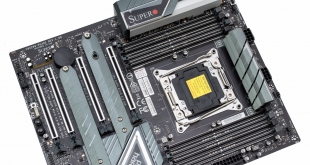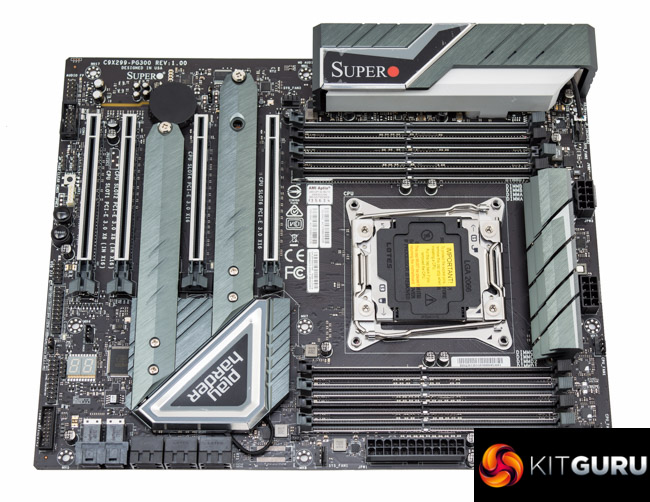
With Intel's X299 platform supporting up to 18-core processors with 165-watt thermal design power, high-quality motherboards with capable power delivery are essential. One company that has long been engineering motherboards for high core-count and high power consumption scenarios is Supermicro.
This respected server vendor has also been manufacturing consumer motherboards since Intel's Z87 generation (2013) and its latest foray into the consumer market is for Intel's X299 chipset with its SuperO C9X299-PG300.

The Supermicro SuperO C9X299-PG300 differs from the typical X299 motherboard from the “big four” of ASUS, ASRock, Gigabyte or MSI. It is immediately clear from the design and presentation of the product that Supermicro's design ethos is server-influenced.
There's something inherently reassuring about a motherboard from a company that hasn't yet mastered the art of gaming gimmicks or marketing, fancy aesthetics and novelty features. The C9X299-PG300 is “more server” than gaming, even if Supermicro have attempted to shape it as a gaming product using the SuperO branding. Think of SuperO to Supermicro along the same lines as what ROG is to ASUS.
There are plenty of high-end connectivity options worthy of X299 including Aquantia 10 Gigabit LAN, dual M.2 slots with cooling, dual U.2 slots, USB 3.1 Type-A and C and Realtek ALC 1150 based audio. The real surprise is Supermicro's decision to fit onboard RGB lighting, which can be controlled by the “SuperO Booster” software, as this suggests more thought has gone into the consumer positioning of this motherboard than just branding.
A quick skim of Supermicro's C422 chipset offerings, that's the chipset that uses the same LGA2066 socket as X299 but for Xeon enterprise processors only, confirms that no obvious rebranding has taken place. Let's see how Supermicro's purpose-built consumer motherboard for Intel X299 stands up to scrutiny.
| Supermicro SuperO C9X299-PG300 | |
| Form Factor | ATX, 30.48cm x 24.38cm |
| CPU Socket | LGA 2066 |
| Chipset | Intel X299 |
| Memory | DDR4, 8 DIMMs*, up to 128GB, 2666MHz+ (faster speeds with overclocking/XMP) *4 DIMMs only on 28-lane CPUs |
| On-board Graphics | None |
| Discrete Graphics | Up to 4-Way graphics card configurations (Nvidia or AMD) |
| Expansion Slots | 4 x PCIe 3.0 X16 (8x/0x/16x/16x or 8x/8x/8x/16x for 44-lane CPUs, 0x/4x/8x/16x for 28-lane CPUs) 1 x PCIe 3.0 X4 (X1 electrical) |
| Storage | 6 x SATA III (via X299 chipset) 2 x M.2 (supports PCIe 3.0 X4 32Gbps, no SATA) 2 x U.2* *On 44-lane CPUs U.2 #1 shares bandwidth with PCIe slot #1, U.2 #2 has dedicated x4 CPU lanes. On 28-lane CPUs U.2 #1 is unavailable and U.2 #2 uses bandwidth from PCIe slot #3 |
| USB | 2 x USB 3.1 (1 Type-C, 1 Type-A, all via ASM3142, 2 Rear) 6 x USB 3.0 (4 Rear, 2 Front, all via Intel X299) 4 USB 2.0 (2 Rear, 2 Front, all via Intel X299) |
| Networking | 1 x Intel I219-V Gigabit LAN RJ45 1 x Aquantia AQC107 10 Gigabit LAN RJ45 |
| Audio | Realtek ALC 1220 7.1 Channel HD Audio |
| RGB | Onboard RGBs (three zones) 2 x 12v G R B connectors |
| Fan Headers | 5, all support 3/4 pin PWM/DC fans (2 x CPU, 3 x SYS) |
| Rear I/O | 1 x PS/2 Keyboard/Mouse combo port 2 x USB 2.0 (black) 2 x USB 3.0 (blue) 2 x USB 3.0 (red) 1 x USB 3.1 Type-A (Red) 1 x USB 3.1 Type-C 1 x Intel Gigabit LAN RJ45 1 x Aquantia 10 Gigabit LAN RJ45 5 x Audio Jacks 1 x Optical S/PDIF |
| UEFI | 128Mb UEFI AMI |
 KitGuru KitGuru.net – Tech News | Hardware News | Hardware Reviews | IOS | Mobile | Gaming | Graphics Cards
KitGuru KitGuru.net – Tech News | Hardware News | Hardware Reviews | IOS | Mobile | Gaming | Graphics Cards


